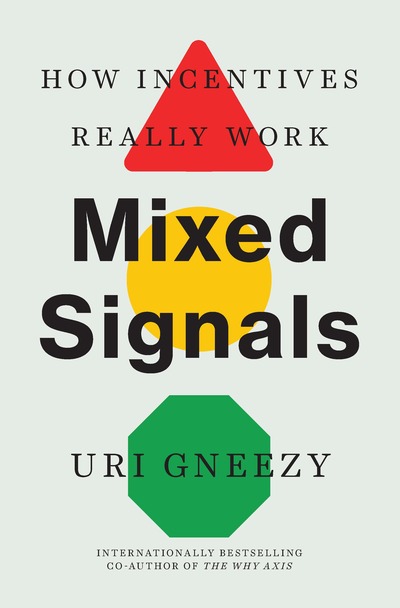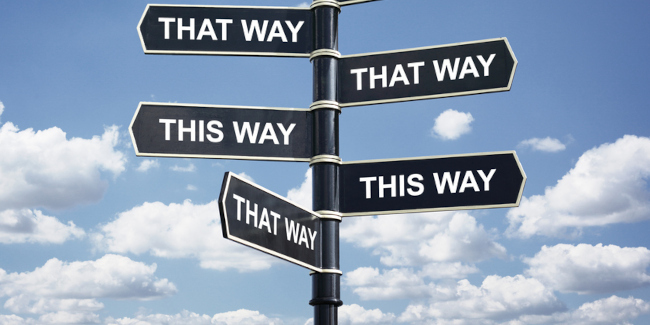If You Think You Understand How Incentives Work, Think Again
Uri Gneezy of the Rady School of Management and author of “Mixed Signals” takes a deep dive into how to create effective rewards systems
Story by:
Published Date
Article Content
How can people be incentivized to drive more fuel-efficient cars, be more innovative at work, and get to the gym on a regular basis? Uri Gneezy, professor of economics and strategy at the Rady School of Management at UC San Diego explains this in his new book “Mixed Signals: How Incentives Really Work.”
In the book, Gneezy, a pioneering behavioral economist, reveals how we can create reward systems that minimize unintended consequences and maximize happiness, health, wealth and success. “Mixed Signals” was recently included in Adam Grant’s 13 New Books to Expand Your Mind in 2023.
“Incentives send a signal,” Gneezy writes, “and your objective is to make sure this signal is aligned with your goals.”
Gneezy, who consistently is named among UC San Diego’s most highly cited researchers, will be giving a public talk on the book Tuesday, March 14 at 5:30 PM, which will be followed by a book signing. The first 200 guests will receive a free copy of the book. Click here to register. In this Q&A, Gneezy explains how anyone can design effective and ethical incentives and why we need them.

How do the incentives for drivers from rideshare apps like Uber and Lyft benefit their customers as well?
Drivers who are paid per ride have an incentive to drive really fast and there are a lot of problems associated with that. For example, Taxis are often not a pleasant ride because drivers are too aggressive and drive too fast. The manager of the taxi company probably tells drivers that it is important to drive safely and be polite, but the incentives they created pushes them in a different direction. One solution is to pay drivers by the hour, so they don’t have incentives to drive aggressively. But then they also don’t have the incentive to be efficient.
What Uber, Lyft and other rideshare companies did, which was very smart, is to add another element to the incentives—a rating system for drivers. Drivers are still incentivized to be efficient, but, if they are too fast or too aggressive or their cars are not clean, passengers will use the rating system to complain. If drivers’ ratings are poor, then they, at some point, are kicked out of the of the service and cannot drive anymore.
Can you share an example of an incentive gone wrong?
There are many, but the Wells Fargo cross-selling scandal is a recent one that impacted millions. The CEO of Wells Fargo wanted to increase the number of accounts that they had with customers. If they had a customer that had a checking account, they also wanted them to open up a credit card or a savings account, etc. So, they decided to incentivize bank employees to do that with a rewards system. The message was: go out and sell more! But they didn't put any checks and balances on their incentive to create more and employees created more than three million false credit card card accounts. Wells Fargo had to fire more than 5,000 employees who participated in the scheme. The problem was that Wells Fargo did not create any audit system to randomly check the validity of the accounts.

“Mixed Signals” was recently included in Adam Grant’s 13 New Books to Expand Your Mind in 2023.
What were the mixed signals in the Wells Fargo case and do any other examples come to mind?
In this example, the mixed signal was about quantity versus quality. For example, the bank wanted to incentivize employees to create more accounts, but neglected the quality side of these new accounts.
You can think of, for example, healthcare. Many doctors are working on what's called a Fee for service (FFS)—the most traditional payment model of healthcare. The more tests, the more procedures, the more money they're paid. These doctors are not paid to get you to be healthy, they're paid to send you to do procedures.
So, the hospital tells the doctor, “you should help the patient, the patient is our number one priority. That's the only thing you should care about.” But then, the hospital pays the doctors based on quantity—how many scans, tests and procedures they prescribe and not based on quality of care.
Why are fines are a problematic incentive in preventing unwanted behavior?
Fines change your perception. It is a break in the social contract. If I tell you “please don't do something” and try to appeal to norms, but then I add a fine to the unwanted behavior, it changes your perception. Now you think about it as an economic interaction in which you start thinking about fine as a price and if it is worth the cost, instead of thinking about the moral aspect of breaking the norm.
Fines send a different message. For example, say that they tell you, “you shouldn't text while driving. It's really stupid. It's really dangerous. Don't do it.” Then you will think, “is it worth risking my life doing this? Not really.” Now, imagine that I also give you a $500 fine for texting while driving, if I catch you. Then you think “Well, there is no cop over here. No one is watching. I can do that.” Instead of thinking that you’re risking your life, you’re thinking instead of the probability of being caught.
You write in the book about examples like Peloton and a California winery, which both saw an uptick in sales when they raised the cost of their product—can you explain that phenomenon?
In many cases, price is an indicator of quality. Say I want to buy a new laptop. If it has bigger memory, it will cost more, if it is lighter, it will cost more. In many cases, we have this relationship where we think “more expensive=better.” You pay for quality, but in some cases, it’s hard to really quantify quality.
Imagine that you go to buy wine and usually you buy a $20 bottle and tonight you’re going to celebrate, so you ask for a $50 wine. You do it because you believe that the more expensive wine is going to be actually better—we make this association. And in some cases, this relation doesn’t work.
Peloton is an example. The CEO said that when they started, they sold the bike at just under $1,200. And many people thought “well if it’s so cheap it can’t be that good.” They then increased the price of the bike to $2000 and people thought, “it’s so expensive, it must be a good product.” The price sends a signal about the quality the product.
You say that paying someone to go to the gym works, but what happens when the financial incentive is removed?
The question is, how do we create habits? I don’t know about you, but many of us have experienced periods in our life in which we went to the gym. And we were happy about this and we were looking forward to it. And then we have periods in our life in which we can’t get off the couch and stop watching Netflix. Why is it so simple to exercise in some periods and so hard in others? One of the reasons is apparently that once you do it, say for a month, then it’s much easier to do it again, because you formed some kind of habit: you know where the gym is, it’s already in your schedule, everything works for you, so it’s easy to continue.
Now, what we tried to do is run an experiment where we pay people, in our case students, money to go to the gym for a month. We hope that after that month they will already form some kind of habit and will continue to go to the gym. And that's what we found, we were successful in creating some kind of habit formation. The problem is that once a winter break or summer break comes along, it breaks the habit to some extent so you need to learn to restart it somehow.
Teamwork is important for any workplace, but incentives too often prioritize individual success. How do we address this?
Every workplace tells you “you need to cooperate with your coworkers, you need to work together” and then they give you individual incentives for your own success, which is a mixed signal. For example, mentoring someone is very important for the success of the company, but mentoring is often not rewarded. If you give employees incentives that are only based on their success, they’re not going to waste time mentoring other people. They will invest in making more sales or whatever it is that they’re expected to do. And so, when you design incentives, you need to understand that giving individual incentives is important and useful, but it comes with a cost. You need to be aware of the cost.
Overall, what is your advice for designing incentives that are effective and ethical?
There are two stages that are important with incentives. You need to remember that your incentives are sending signals. Before you set the incentive, think about what is it that you're signaling. You just have to use common sense. For example, don’t just assume that because you are assigning a fine or reward to something, that it will create the intended consequence. You are changing the meaning of interaction. Now, it's about how much it's going to cost.
And the second part is that you need to test what you're doing. Don't assume that you will know how people will react to the incentive. Try to run an experiment very much like companies do with A/B testing. Test your incentive, try this incentive and another incentive and see which one works better. Keep testing it and keep improving it because people will find ways to gain from your incentive, so make sure that you are ready for it and prepared.
Share This:
You May Also Like
UC San Diego is Strengthening U.S. Semiconductor Innovation and Workforce Development
Technology & EngineeringStay in the Know
Keep up with all the latest from UC San Diego. Subscribe to the newsletter today.




